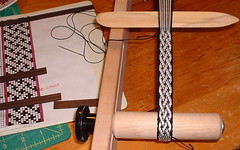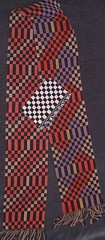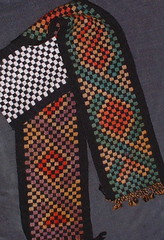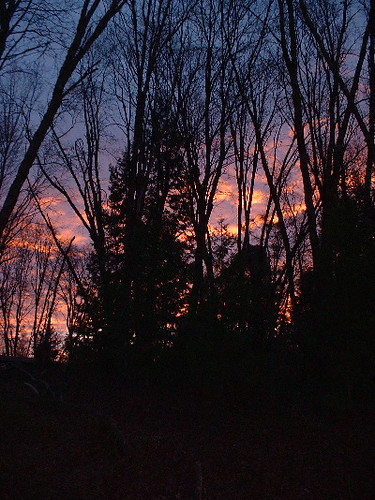Small Wonders
Well, weaving has not been very visible lately, at least on this blog. Charleen, Valerie and Carolyn have been holding up the standard though. They have lots of good weaving information in their latest posts.
Right now I am weaving an inkle band, and it is just delightful. The pattern comes from here, and I set it up as an alternating tabby and pattern thread weave structure (what Mary M. Atwater called a staggered set up, for Mexican and European pick up bands, in her book Byways in Handweaving).

My guild has volunteered to demonstrate pick up inkle weaving at the CNCH conference this coming May, so this Saturday we are doing a practice run at our spinning meeting.
I set this up to see how it works, and whether it was a feasible demo band. There is an optimum way to weave these pattern types: the starting position on the pattern and starting shed determine how easy or complicated the pick up will be. The first test sample I did, I knew right away that I was weaving on the wrong sheds: each pass required too many drops and pickups to achieve the pattern. I stopped and re-oriented the sheds so it would flow more smoothly. I'll use the first small sample as a bookmark or something: it looks fine, it was just annoying to weave.
I learned pick techniques from Ed Franquemont (complementary pickup) and then later several other techniques from Jaquetta Nisbett. It's a fun thing to do, and the bands can be useful, although I rarely do anything with them: I just make them.
This band is rayon, which I bought several years ago at the Handweaver's Studio, in London. The background and selvedge threads are a black 2 ply, and the pattern threads are a chained rayon, used double. I plan to paint the white with dyes thickened with alginate: the pattern is a three-element braid, and the dye will emphasize the structure.
I've done this painting technique with other fabrics, here is a complementary pickup band, where each block is dyed a different color:

And here is a handspun silk doubleweave with a small piece of the original fabric, showing both sides of the painted fabric:

You can see how this technique allows me to make a somewhat simple fabric much more complex: colors appear and disappear as if they were woven of many more harnesses than eight, and I can paint both sides differently.
Here is the same thing done on a wool/angora handspun supplementary warp, also the original black and white sample, plus both sides of the painted fabric:

I've tried samples of knit fabrics with this painting technique too:

The fabric certainly looks more complex than it is: there are 5 colors across some rows, but I only knit with two!
The possibilities are just boggling, that is, if you have the desire to sit and paint tiny little squares with thickened dye. Apparently I do.
I leave you with this morning's sky:

a good beginning for a new day.
Right now I am weaving an inkle band, and it is just delightful. The pattern comes from here, and I set it up as an alternating tabby and pattern thread weave structure (what Mary M. Atwater called a staggered set up, for Mexican and European pick up bands, in her book Byways in Handweaving).

My guild has volunteered to demonstrate pick up inkle weaving at the CNCH conference this coming May, so this Saturday we are doing a practice run at our spinning meeting.
I set this up to see how it works, and whether it was a feasible demo band. There is an optimum way to weave these pattern types: the starting position on the pattern and starting shed determine how easy or complicated the pick up will be. The first test sample I did, I knew right away that I was weaving on the wrong sheds: each pass required too many drops and pickups to achieve the pattern. I stopped and re-oriented the sheds so it would flow more smoothly. I'll use the first small sample as a bookmark or something: it looks fine, it was just annoying to weave.
I learned pick techniques from Ed Franquemont (complementary pickup) and then later several other techniques from Jaquetta Nisbett. It's a fun thing to do, and the bands can be useful, although I rarely do anything with them: I just make them.
This band is rayon, which I bought several years ago at the Handweaver's Studio, in London. The background and selvedge threads are a black 2 ply, and the pattern threads are a chained rayon, used double. I plan to paint the white with dyes thickened with alginate: the pattern is a three-element braid, and the dye will emphasize the structure.
I've done this painting technique with other fabrics, here is a complementary pickup band, where each block is dyed a different color:

And here is a handspun silk doubleweave with a small piece of the original fabric, showing both sides of the painted fabric:

You can see how this technique allows me to make a somewhat simple fabric much more complex: colors appear and disappear as if they were woven of many more harnesses than eight, and I can paint both sides differently.
Here is the same thing done on a wool/angora handspun supplementary warp, also the original black and white sample, plus both sides of the painted fabric:

I've tried samples of knit fabrics with this painting technique too:

The fabric certainly looks more complex than it is: there are 5 colors across some rows, but I only knit with two!
The possibilities are just boggling, that is, if you have the desire to sit and paint tiny little squares with thickened dye. Apparently I do.
I leave you with this morning's sky:

a good beginning for a new day.

3 Comments:
Fascinating! I think I would be content to sit and paint little squares. The results are well worth it.
So, if I go to CNCH I'll get to see *you* and that bit of inkle weaving in person? Hmmm...
The link for the inkle pattern-celtic knotwork-seems to be gone. Any chance that you might post the pattern/directions on your blog?
Thanks
Leigh
Post a Comment
<< Home